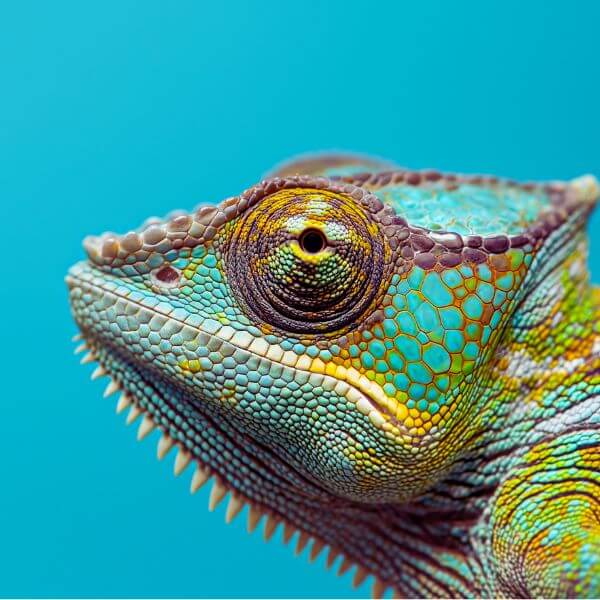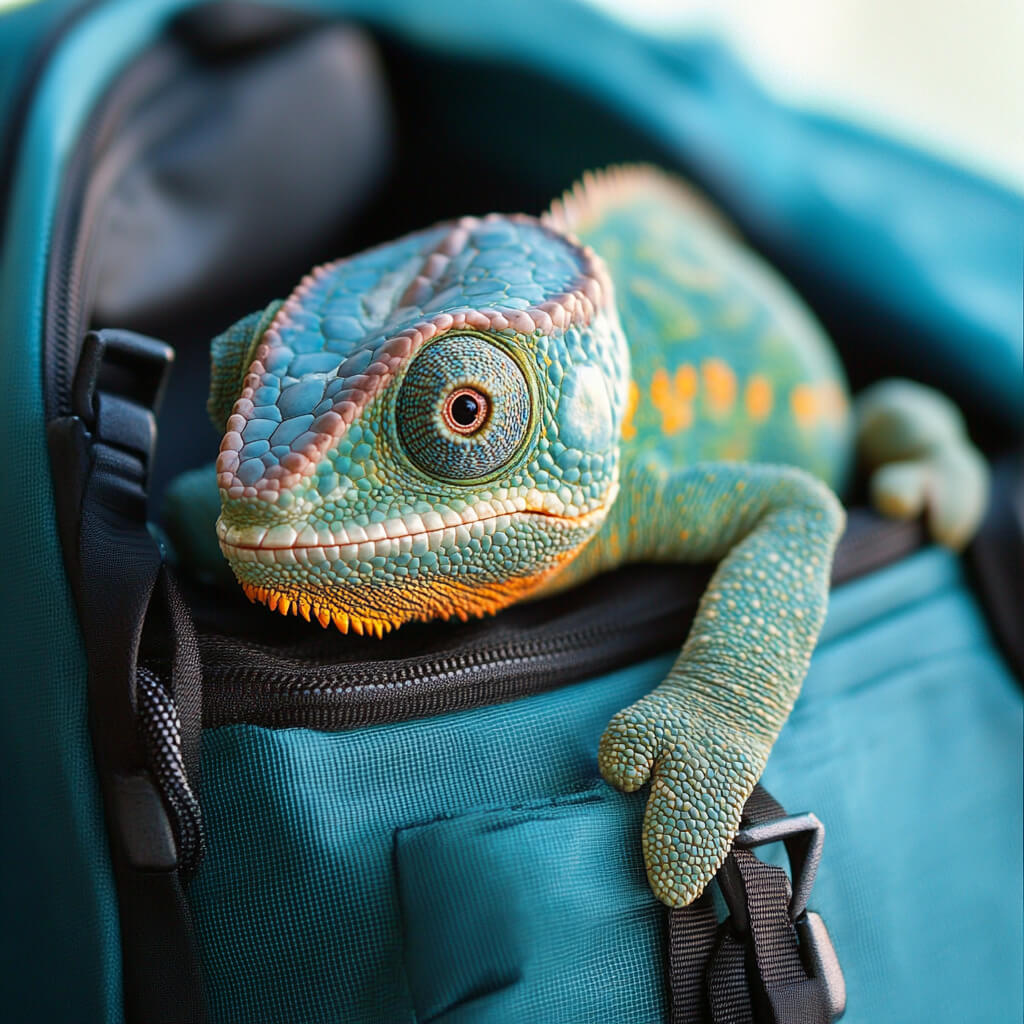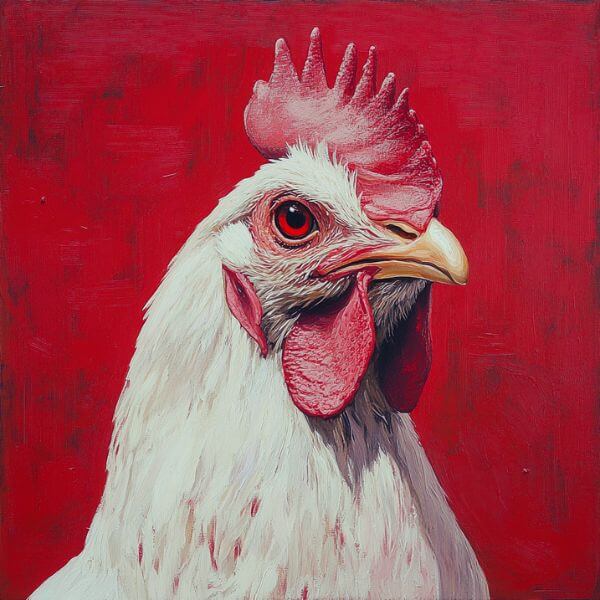No, it’s uncommon for chameleons of any species don’t typically eat their own shed.
They’re not like some other lizards who see their old skin as a snack.
Why some reptiles eat their shed
Some lizards do eat their shed, though. It’s like recycling for reptiles! They do it to:
- Get back some nutrients
- Hide from predators
- Keep their home clean
Comparing chameleons to other shed-eating lizards
Let’s see how chameleons stack up against some shed-munching lizards:
| Lizard | Eats Shed? |
| Chameleon | Nope |
| Gecko | Yep |
| Bearded Dragon | Sometimes |
| Green Iguana | Rarely |
Risks of chameleons eating their shed
Even though chameleons don’t usually eat their shed, what if they did? Let’s look at the potential oopsies.
Potential health concerns
If a chameleon did eat its shed, it might:
- Get a tummy ache
- Have trouble pooping
- Risk getting parasites
Impact on chameleon nutrition
Eating shed isn’t a balanced diet for chameleons. They need proper chameleon food to stay healthy and happy.
Proper chameleon care during shedding
Let’s talk about how to be a top-notch chameleon parent during shedding time.
Creating the right environment for shedding
Make your chameleon’s home shed-friendly:
- Keep it humid (but not too wet!)
- Provide lots of branches for rubbing
- Make sure the temperature is just right
Helping chameleons shed safely
You can lend a hand (gently!) by:
- Misting your chameleon with warm water
- Providing a ‘shedding perch’ with rough bark
- Never pulling off loose skin yourself
Addressing shedding problems
Sometimes shedding doesn’t go smoothly. Watch out for:
- Skin staying stuck for too long
- Swelling or redness
- Your chameleon seeming stressed
If you see these signs, it might be time to chat with a reptile vet.
Understanding the chameleon shedding process
Let’s talk about how chameleons shed. It’s not like they’re taking off a coat – it’s more like they’re peeling off a whole bodysuit!
How often do chameleons shed?
Chameleons are pretty busy when it comes to shedding. Check out this quick rundown:
| Age | Shedding Frequency |
| Baby | Every few weeks |
| Young | Once a month |
| Adult | Every 1-2 months |
Signs of chameleon shedding
Wondering if your scaly buddy is about to shed? Look out for these clues:
- Dull, grayish color
- Less appetite
- More hiding than usual
- Rubbing against branches
Stages of chameleon molting
Shedding isn’t a one-and-done deal. It’s like a mini makeover in stages:
- Pre-shed: Your chameleon might look a bit off-color.
- Starting to peel: Little bits of skin start coming loose.
- The big shed: Large pieces of skin come off.
- Post-shed shine: Your chameleon looks bright and new!
Chameleon diet and nutrition
Since chameleons aren’t chowing down on their old skin, what should they be eating?
What do chameleons normally eat?
Chameleons are bug hunters! Their menu usually includes:
Meeting nutritional needs without shed consumption
To keep your chameleon healthy, make sure they get:
- A variety of insects
- Gut-loaded prey (insects fed nutritious food)
- Calcium and vitamin supplements
Species-specific shedding information
Not all chameleons shed the same way. Let’s look at a couple of popular pet chameleons.
Veiled chameleon shedding behavior
Veiled chameleons, with their cool head crests, tend to:
- Shed more often when young
- Have a pretty easy time shedding
- Sometimes eat a bit of plant material during shedding (but not their shed!)
Panther chameleon molting process
Panther chameleons, known for their bright colors, typically:
- Have very colorful sheds
- Shed in patches rather than all at once
- Might need extra humidity to shed well
FAQs about chameleon shedding
Is it normal for chameleons to eat their shed?
Nope, it’s not normal. If you see your chameleon nibbling its shed, it might be confused or stressed.
How can I tell if my chameleon is about to shed?
Look for dull colors, less eating, and more hiding. It’s like they’re getting ready for their big reveal!
What should I do if my chameleon has trouble shedding?
First, up the humidity. If that doesn’t work, a warm, gentle mist can help. Still stuck? Time for a vet visit.
Can chameleons get sick from eating their shed?
They could, but it’s rare since they don’t usually eat it. It might cause tummy troubles if they do.
How long does the shedding process take for chameleons?
It can take anywhere from a few hours to a few days. Patience is key!
Conclusion
Chameleons don’t eat their shed – they’re too busy changing colors and catching bugs.
Remember, a happy chameleon is one that sheds easily and has a belly full of insects, not old skin.
Keep your scaly friend’s home comfy, feed them well, and enjoy watching their amazing shedding process.
It’s like having a mini-makeover artist in your home!







Leave a Reply